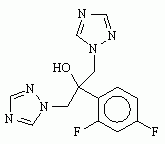Upon the application of the Hungarian based firm Richter Gedeon, the FDA has tentatively approved an abbreviated new drug application for a generic version of Pfizer's Diflucan[TM] (fluconazole). Final approval depends on whether Pfizer's patents on Diflucan will expire as scheduled next year. or if the company will seek an extension. The generic drug would be marketed in the U.S. through a partnership with Barr Laboratories.
FDA Grants Fast Track Product Designation For Abthrax (PA mAb) for Prevention, Treatment of Anthrax Infections
Human Genome Sciences, Inc. received a Fast Track Product designation from the U.S. Food and Drug Administration (FDA) for ABthrax (PA mAb), a novel drug for the prevention and treatment of anthrax infections. For a new drug to be designated a Fast Track Product, the condition it is designed to treat must be serious or life-threatening, and must represent an unmet medical need. The FDA also must determine that the drug has the potential to address the unmet medical need and that the development program is designed to evaluate this potential.
ABthrax is a human monoclonal antibody to Bacillus anthracis protective antigen that was discovered and developed by Human Genome Sciences. ABthrax has been shown to be effective in protecting against anthrax in multiple experimental models in animals. A single dose of ABthrax increases survival significantly in both rabbit and nonhuman primate models of inhalational anthrax. Human Genome Sciences has initiated a Phase 1 placebo-controlled, dose-escalation clinical trial of ABthrax in healthy adult volunteers to evaluate the safety, tolerability and pharmacokinetics of ABthrax. The trial will evaluate different dose levels of intramuscularly administered ABthrax and intravenously administered ABthrax.
According to the guidelines set forth in the Bioterrorism Act of 2002, the FDA stated that successful studies in relevant animal models will be considered sufficient to establish efficacy for licensure and marketing approval. ABthrax has been demonstrated to be effective in preventing the lethal effects of anthrax infection in two relevant models, rabbits and nonhuman primates. According to the guidelines, clinical trials will be required to establish safety, tolerability, and pharmacology, but not efficacy.
COPYRIGHT 2003 Journal of Drugs in Dermatology
COPYRIGHT 2004 Gale Group



